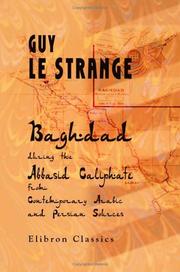Ancient Baghdad’s Street Plan
 When you’re researching you sometimes stumble onto books that seem to have been written just for you.
When you’re researching you sometimes stumble onto books that seem to have been written just for you.
I’ve read a long shelf’s worth of interesting and sometimes wonderful texts about 8th century Arabia, both primary and secondary sources (and a whole lot of books about ancient history in the region). Yet one in particular was almost perfectly suited to what I was writing, and once I found it I had one of those Homer “doh” moments.
It had been mentioned in the bibliography of one of my early sources. I can only assume that I tried to look for it twelve or thirteen years ago and couldn’t find a copy, but it could be that I simply missed it.
The full title of the book is Baghdad During the Abbasid Caliphate from Contemporary Arabic and Persian Sources, and should tell you just how vital the book would be to anyone bringing a story to life in 8th century Baghdad. I wish that I’d had it at hand when I wrote The Desert of Souls. I assure you that I keep it close by as I draft The Maiden’s Eye, which takes place almost entirely within Baghdad itself over the course of a single week.
The volume was first published in 1900, though God alone knows how long it took author Guy le Strange to assemble the pieces. His prefatory note suggests that he began consideration of the project some seventeen years prior to its completion. Keep in mind that Baghdad has been continuously inhabited since its founding. Trying to come up with its layout is a lot more complex than, say, mapping the streets of a city that’s been lying in ruins for thousands of years, like Nineveh. Not only is a lot of stuff just not there anymore, everything about that “stuff” has been recycled into other buildings or built over or buried.
le Strange combed through every contemporary source he could find about the buildings, streets, canals, cemeteries, parks palaces, mosques — really, ANYTHING that was known to exist in ancient Baghdad — and then arranged them textually so that you are reading a travel guide to ancient Baghdad. If Dabir and Asim are wandering down a street, by God, I know it’s not just any street, but the high road leading southeast of the Basra gate into the Eastern Quarter. And naturally Dabir would wander there because there were booksellers arrayed on both sides of the street for the equivalent of many blocks. I can rough out a sentence like the following and plan to add a little more detail about the archway itself in final draft because it was really there.
Dabir was quiet through all of this until we passed under the Harranian Archway, a wide brick monument useful really only for the roosting of pigeons, although beggars and a few trinket sellers were set up in it shadow.
There is really only one drawback to the book. Because le Strange really wasn’t writing the book just for me, streets and landmarks from every era of the caliphate are listed, including a century or more after the time of my characters. I must always be very careful that I’m not having Dabir and Asim wander past something that wouldn’t exist yet.
Sometimes I do alter the course of history in these books, obviously (apart from, you know, magic and monsters being real). I mentioned in the afterword to The Desert of Souls that The House of Wisdom was really only in an embryonic state during Harun al-Rashid’s time, but that the place was so wonderful I wished Dabir to have studied there. History buffs might have noticed that Asim mentioned “the old man in the mountain” in The Bones of the Old Ones, a figure who wouldn’t have existed for several hundred more years — again, though, that was deliberate, for what middle-eastern adventure series would be truly complete without the threat of the ancient assassin cult? (Not that I intend to use him anytime soon — I just want to leave the option open.)
But an accidental historical inaccuracy, Dabir and Asim hiding in the shadow of a monument that wasn’t there, or praying at a mosque that hadn’t been built yet, would make me cringe. I’m sure it’s bound to happen sooner or later, and may, indeed, already have happened, but I’ll keep researching to cut down on its likelihood.
And besides, I love reading about the period. If I didn’t, why on earth would I be writing about the 8th century in the first place?
3 Comments